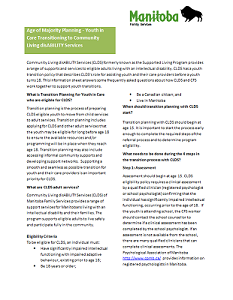Community Living disABILITY Services
Age of Majority Planning -
Youth in Care Transitioning to Community Living disABILITY Services
Community Living disABILITY Services (CLDS) formerly known as the Supported Living Program provides a range of supports and services to eligible adults living with an intellectual disability. CLDS has a youth transition policy that describes CLDS’s role for assisting youth and their care providers before a youth turns 18. This information sheet answers some frequently asked questions about how CLDS and CFS work together to support youth transitions.
What is Transition Planning for Youth in Care who are eligible for CLDS?
Transition planning is the process of preparing CLDS eligible youth to move from child services to adult services. Transition planning includes applying for CLDS and other adult services that the youth may be eligible for long before age 18 to ensure the available resources and/or programming will be in place when they reach age 18. Transition planning may also include accessing informal community supports and developing support networks. Supporting a smooth and seamless as possible transition for youth and their care providers is an important priority for CLDS.
What are CLDS adult services?
Community Living disABILITY Services (CLDS) of the Department of Families provides a range of support services for Manitobans living with an intellectual disability and their families. The program supports eligible adults to live safely and participate fully in the community.
Eligibility Criteria
To be eligible for CLDS, an individual must:
· Have significantly impaired intellectual functioning with impaired adaptive behaviour, existing prior to age 18;
· Be 18 years or older;
· Be a Canadian citizen or legally entitled to permanently live and work in Canada; and
· Live in Manitoba
When should transition planning with CLDS start?
Transition planning with CLDS should begin at age 15. It is important to start the process early enough to complete the required steps of the referral process and to determine program eligibility.
What needs to be done during the 4 steps in the transition process with CLDS?
Step 1: Assessment
Assessment should begin at age 15. CLDS eligibility policy requires a clinical assessment by a qualified clinician (registered psychologist or school psychologist) confirming that the individual has significantly impaired intellectual functioning, occurring prior to the age of 18. If the youth is attending school, the Child and Family Services (CFS) worker should contact the school counsellor to determine if a clinical assessment has been completed by the school psychologist. If an assessment is not available from the school, there are many qualified clinicians that can complete clinical assessments. The Psychological Association of Manitoba provides information on registered psychologists in Manitoba.
Step 2: Referral
The referral process should begin at age 15. The CFS worker should submit a referral application along with supporting documentation and clinical assessment to CLDS before age 16. The supporting documentation includes: professional assessments; school reports; family /social history; etc.; that shows that the individual meets CLDS eligibility criteria and provides helpful information for future planning purposes. If a clinical assessment is not immediately available, the CLDS referral should still be submitted to the appropriate departmental office. The clinical assessment should be forwarded to CLDS as soon as possible.
Step 3: Planning
Planning should have started well before the youth’s 17th birthday. The CFS worker and Community Service Worker (CSW) meet with the youth, family and other supports. Planning should focus on: developing knowledge of the youth by sharing information about preferences, abilities, and experiences; the youth’s aspirations for adulthood; determining the resources the youth will need into adulthood; ensuring all adult Residential Care Licensing (RCL) requirements are identified and understood; and identifying the supports that are available at home, in the community and at school (if applicable) to prepare for the transition into adulthood.
Step 4: Transition
Thoughtful and collaborative planning ensures the individual successfully transitions into CLDS in a seamless manner. The plan may be for the young adult to continue to live in a long term foster arrangement with CLDS assuming case management, licensing and funding responsibilities or for the young adult to transition into a new living environment (independent living, adult foster placement, community residence, etc.). The successful placement option requires advance planning and collaboration between the child and adult systems.
Contacting CLDS
To find the contact information for your local CLDS office, please visit the Community Living disABILITY Services web page.


